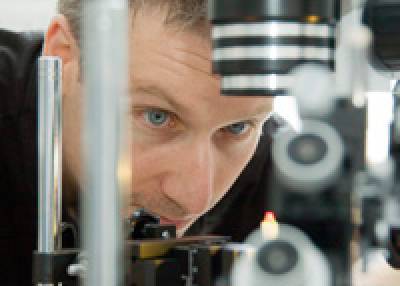Joerg Albert is a Professor of Sensory Biology and Biophysics
My fascination with the field of sensory biology and neuroscience dates back to the summer of 1981, I guess. Rather than reflecting the (prematurely) academic mind of a 10-year old school boy, it resulted from a summer-long observation of a population of hunting spiders in my parents’ orchard (including some first detailed anatomical inspections with a freshly acquired little toy microscope). Spiders, these predominantly nocturnal beings that so radically (and some even blindly) relied on their mechanosensory skills of detecting the minutest of all vibrations to tell predator from prey, impressed me deeply. So, at least in retrospect, it seems to have been just a matter of course that I eventually turned my professional interests to the biological sciences and my biological interests to the field of mechanosensation, i.e. the sensations of touch, balance, vibration and hearing. For my PhD, I joined the neurobiology lab of Friedrich G. Barth at the University of Vienna where I became familiar with the imposing richness of spider mechanosensory organs. In the biophysics lab of Martin Göpfert at the University of Cologne then, I was lucky enough to spend a fantastic 4-year ‘postdoc’ time during which I not only converted from a spider- to an insect-man but- even more- to a confessing Drosophilist (!). Accordingly, I shifted the centre of my research interest from the touch sense of spiders to the antennal ears of the fruit fly Drosophila melanogaster.
At a place like the UCL Ear Institute which is so explicitly dedicated to the understanding of human hearing and deafness it might appear a little eccentric to investigate the ears of fruit flies, but it is nothing like that. After all, fruit flies and mammals (like mice and men) share a common evolutionary history of roughly 3 billion years which is still reflected by a considerable overlap of the molecular machineries that orchestrate the development of their ears. The fly gene atonal, for example, has a very similar mouse counterpart, called MATH1. Most intriguingly, atonal can fully rescue the phenotype of MATH1-deficient mice, convincingly demonstrating the equivalence and conservation of the proteins' developmental functions. In addition to this kind of molecular kinship, a second force is producing congruencies between auditory systems across the taxa and this is to do with physical constraints: Both the ears of flies and humans are faced with very similar biophysical problems and they, obviously, came to very similar solutions. And, finally, much of what we know about the workings of our own ears we have learned from experiments in animals as strange as bullfrogs, turtles or chicken. So why not let little Drosophila contribute to our understanding of hearing and deafness? I am sure this can fly.
 Close
Close


